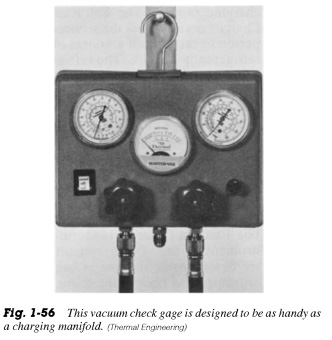Evacuation System
How long should it take? Some methods of evacuation will be pure air conditioning and refrigeration systems to such an extent, had never reached that place. When used properly, a good vacuum pump will eliminate 99.99 percent of the air and almost all the moisture in the system. No clear answer to the question about the time required pump, to achieve this level of purity. The time required for evacuation depends on many things. Some of the factors that must be considered are:
- The size of the vacuum pump
- Type vacuum pumpsingle or two-stage
- The size of the hose connections
- The size of the system
- Pollution in the
- Applications for the system
Evacuation sometimes take fifteen minutes. Then again, they might take a few weeks. The only way to know when evacuation is complete take micron vacuum reading, using a good electronic vacuum gage. A number of electronic counters. Cm. Fig. 1-56 and 1-57.
Evacuate to 29. eliminates 97 percent of all air. Removal of moisture, however, does not begin until vacuum below 29.
achieved. It micron level of the vacuum. It can only be measured with electronic vacuum gage. Dehydration system, of course, will not begin until vacuum gage below 5000 microns. If the system can't pump up to this level, something is wrong. There may be a leak in the vacuum connections. Vacuum pump oil can be dirty. There may be a leak in the system. Vacuum gage reading between 500 and 1000 microns assure that dehydration is a continuation. When all moisture is removed, micron gage will pull down below 1000 microns.
Pulling down the system below 1000 microns is not a perfect test of purity. If the vacuum pump is too large for the system, it can pull down this level before all moisture is removed. Another test is preferred. Once the system is lowered below 1000 microns went no further. The system should be off valve from the vacuum pump and the pump is switched off. If the vacuum in the system does not exceed 2000 microns in next 5 minutes, the evacuation was completed. If it goes beyond this level, or the moisture is not completely removed, or the system has a small leak. To find which, reevacuate system to the lowest level. Valve again and turned off the vacuum pump. If a vacuum leak back to the same level as before, there is a leak in the system. If, growth is much slower than before, a small amount of moisture is likely to remain in the system. Reevacuate until vacuum will.
 .. ..
|

 ..
..